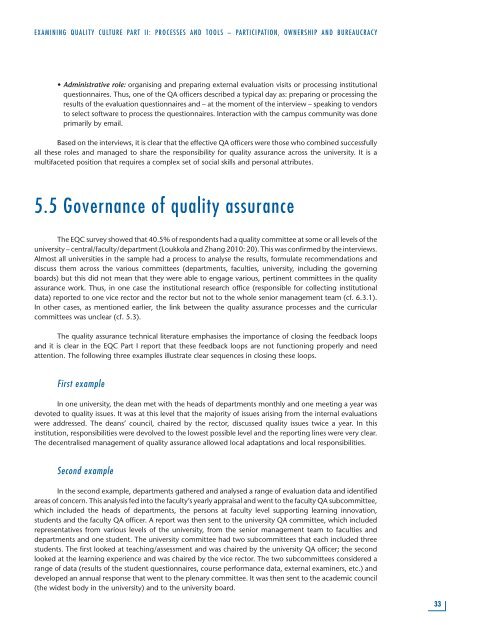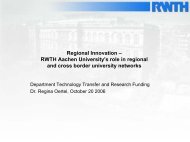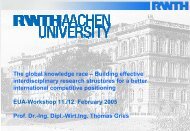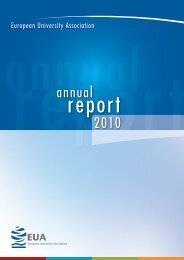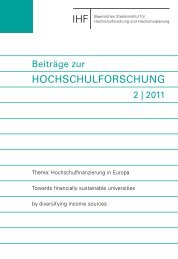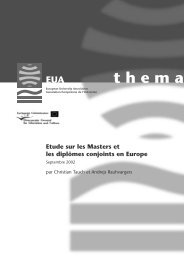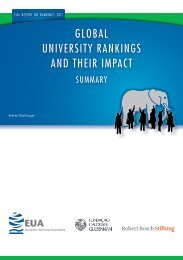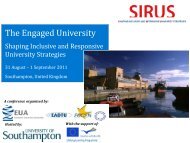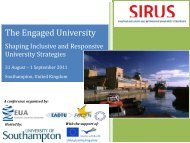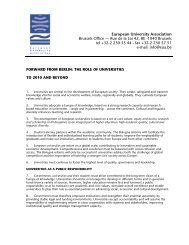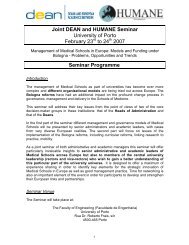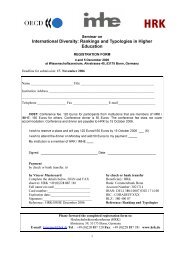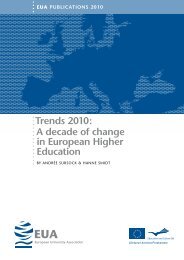Examining Quality Culture Part II: - European University Association
Examining Quality Culture Part II: - European University Association
Examining Quality Culture Part II: - European University Association
Create successful ePaper yourself
Turn your PDF publications into a flip-book with our unique Google optimized e-Paper software.
ExAmININg QUALITy CULTUrE PArT <strong>II</strong>: PrOCESSES ANd TOOLS – PArTICIPATION, OwNErShIP ANd BUrEAUCrACy<br />
• Administrative role: organising and preparing external evaluation visits or processing institutional<br />
questionnaires. Thus, one of the QA officers described a typical day as: preparing or processing the<br />
results of the evaluation questionnaires and – at the moment of the interview – speaking to vendors<br />
to select software to process the questionnaires. Interaction with the campus community was done<br />
primarily by email.<br />
Based on the interviews, it is clear that the effective QA officers were those who combined successfully<br />
all these roles and managed to share the responsibility for quality assurance across the university. It is a<br />
multifaceted position that requires a complex set of social skills and personal attributes.<br />
5.5 governance of quality assurance<br />
The EQC survey showed that 40.5% of respondents had a quality committee at some or all levels of the<br />
university – central/faculty/department (Loukkola and Zhang 2010: 20). This was confirmed by the interviews.<br />
Almost all universities in the sample had a process to analyse the results, formulate recommendations and<br />
discuss them across the various committees (departments, faculties, university, including the governing<br />
boards) but this did not mean that they were able to engage various, pertinent committees in the quality<br />
assurance work. Thus, in one case the institutional research office (responsible for collecting institutional<br />
data) reported to one vice rector and the rector but not to the whole senior management team (cf. 6.3.1).<br />
In other cases, as mentioned earlier, the link between the quality assurance processes and the curricular<br />
committees was unclear (cf. 5.3).<br />
The quality assurance technical literature emphasises the importance of closing the feedback loops<br />
and it is clear in the EQC <strong>Part</strong> I report that these feedback loops are not functioning properly and need<br />
attention. The following three examples illustrate clear sequences in closing these loops.<br />
First example<br />
In one university, the dean met with the heads of departments monthly and one meeting a year was<br />
devoted to quality issues. It was at this level that the majority of issues arising from the internal evaluations<br />
were addressed. The deans’ council, chaired by the rector, discussed quality issues twice a year. In this<br />
institution, responsibilities were devolved to the lowest possible level and the reporting lines were very clear.<br />
The decentralised management of quality assurance allowed local adaptations and local responsibilities.<br />
Second example<br />
In the second example, departments gathered and analysed a range of evaluation data and identified<br />
areas of concern. This analysis fed into the faculty’s yearly appraisal and went to the faculty QA subcommittee,<br />
which included the heads of departments, the persons at faculty level supporting learning innovation,<br />
students and the faculty QA officer. A report was then sent to the university QA committee, which included<br />
representatives from various levels of the university, from the senior management team to faculties and<br />
departments and one student. The university committee had two subcommittees that each included three<br />
students. The first looked at teaching/assessment and was chaired by the university QA officer; the second<br />
looked at the learning experience and was chaired by the vice rector. The two subcommittees considered a<br />
range of data (results of the student questionnaires, course performance data, external examiners, etc.) and<br />
developed an annual response that went to the plenary committee. It was then sent to the academic council<br />
(the widest body in the university) and to the university board.<br />
33


